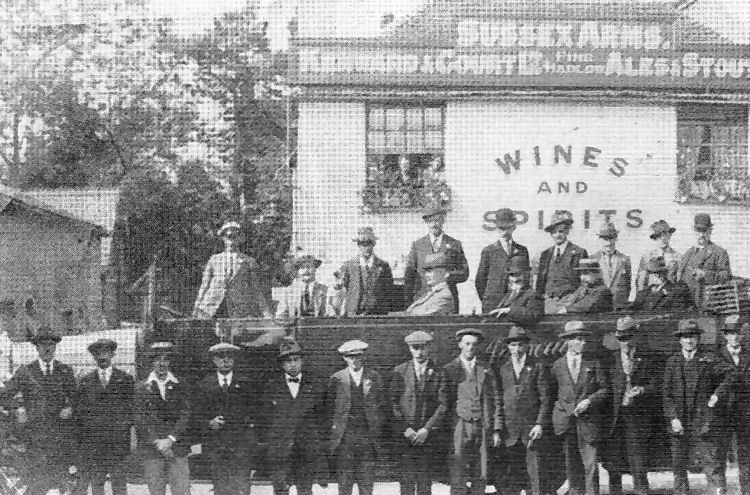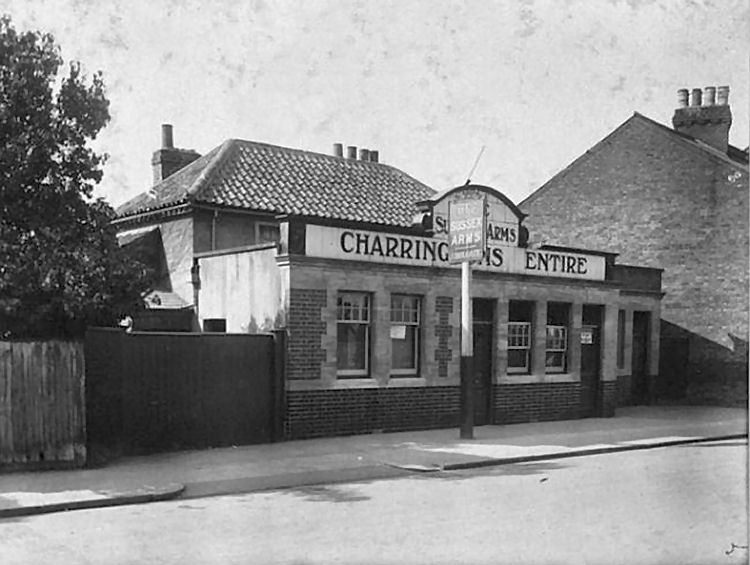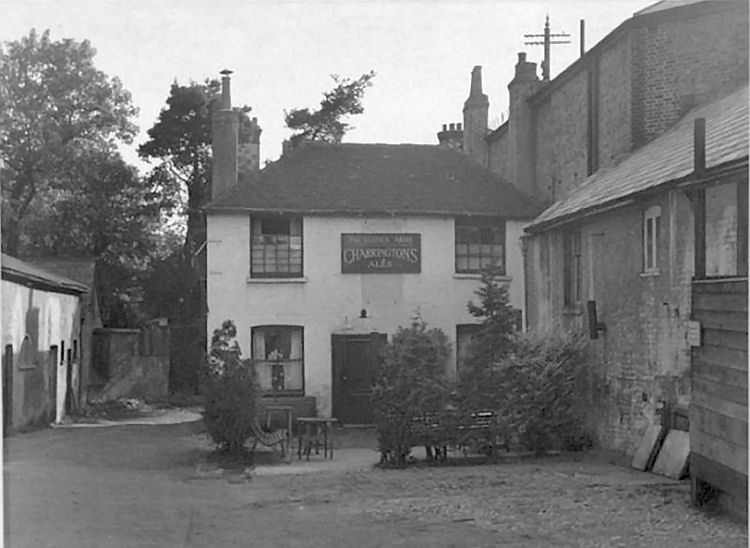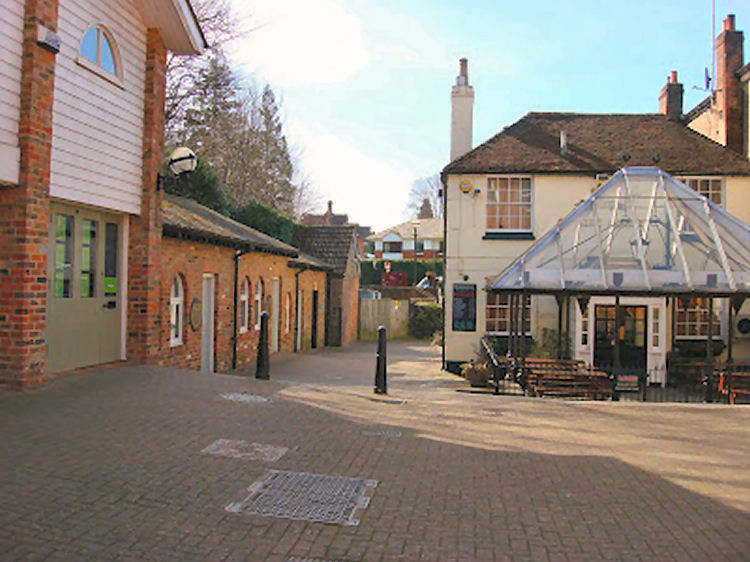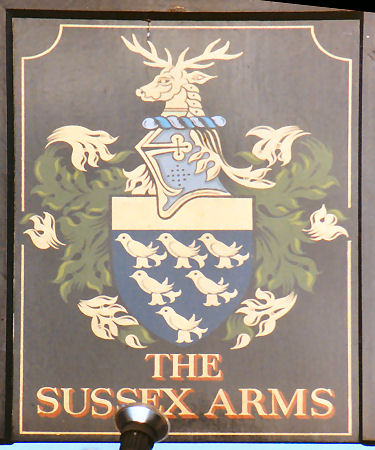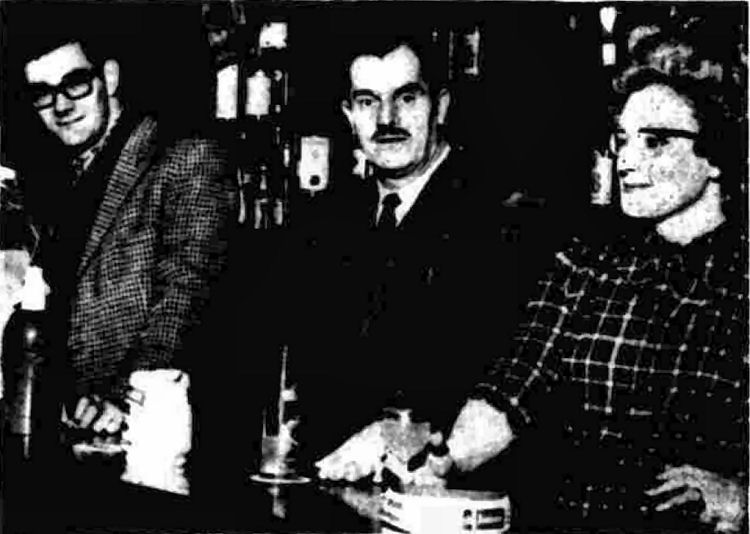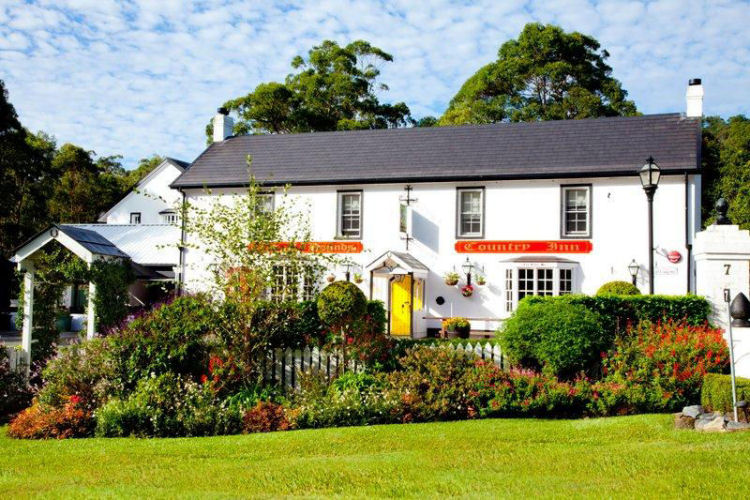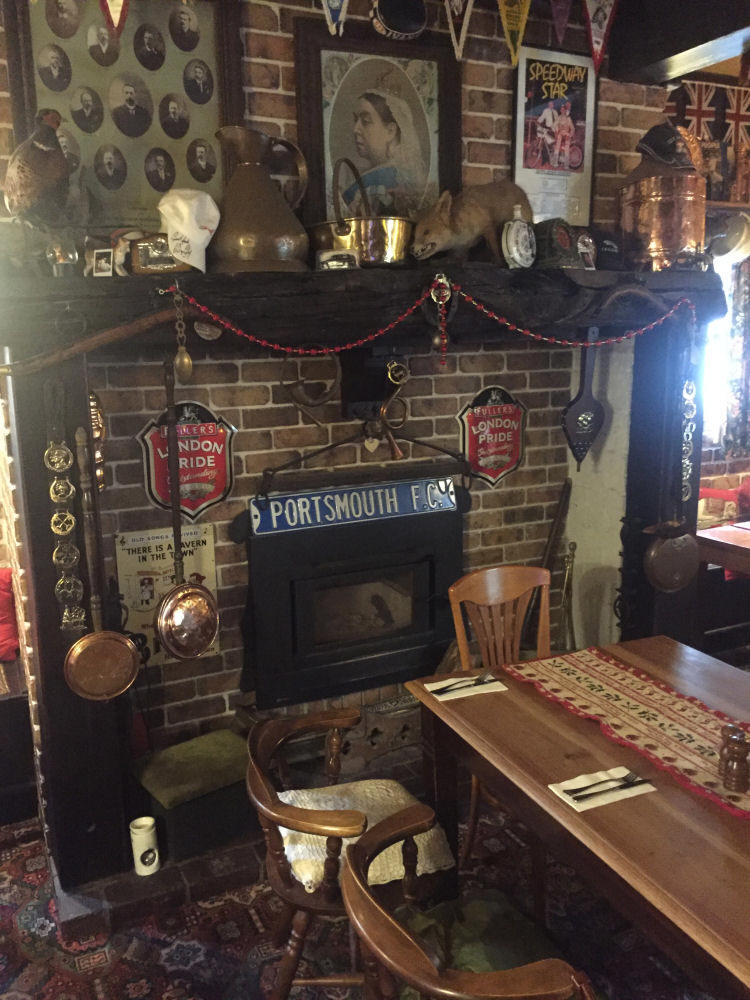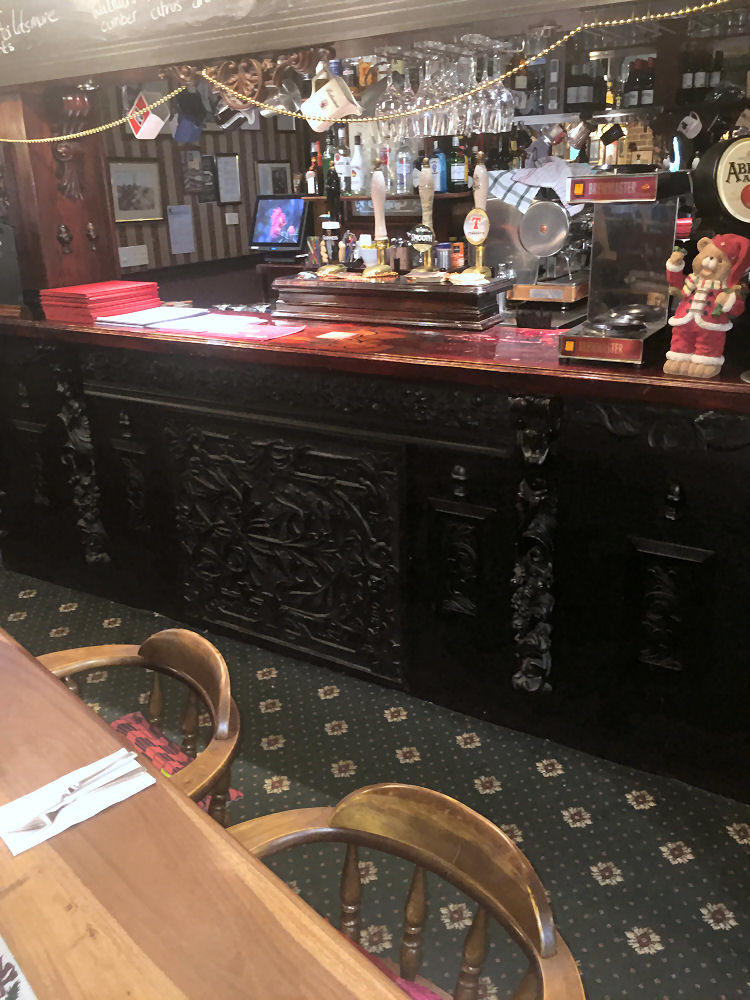|
THE SUSSEX SHADES PUBLIC HOUSE
Written By: Edward James Gilbert - Thunder Bay, Ontario, Canada. 5 February 2015
The Sussex Shades public house dates back to the 17th
century. It is situated in the Sussex Mews, behind the once grand Sussex
Hotel. Tucked away through Coach and Horse Passage. This old
establishment began as a watering hole for the weary traveller arriving
by horse and carriage. The boundary between Frant, Sussex and Tunbridge
Wells, Kent ran through the middle of the Sussex Hotel, putting the
Sussex Shades in Sussex, until at a later time the boundary was changed
and it became part of Kent. The pub has a long and sometimes eccentric
history.
In the 17th to 19th century this pub was known variously as the
"Sussex Tavern" and the "Sussex Shades" but in the 20th century became
known as the "Sussex Arms," a name it retains today. Like most pubs it
has seen good times and bad and most who visited it described it as a
rather rough and dark place, due to its location in the shade cast upon
it by surrounding taller buildings. Today it is a more cheerful and
vibrant place where good meals and beverages are served and is popular
among tourists and locals alike. This article traces the history of the
pub and its proprietors.
LOCATION AND DESCRIPTION
Situated on Sussex Mews behind the Pantiles' Corn Exchange sits one
of Tunbridge Wells' most historic pubs. Tucked away through Coach and
Horse Passage, The Sussex is the area's best-kept secret. The adjacent
"Sussex Hotel" gave its name to the pub, and according to the tradition
of a pub serving a hotel, the pub was known as ‘the Sussex Shades.'
“Mews” is a primarily British term formerly describing a row of
stables, usually with carriage houses below and living quarters above,
built around a paved yard or court, or along a street, behind large city
houses, such as those found in towns, during the 17th and 18th
centuries. The word may also refer to the lane, alley or back street
onto which such stables open. It is sometimes applied to rows or groups
of garages or, more broadly, to a narrow passage or a confined place.
Today most mews stables have been converted into dwellings.
The shops, inns and hotels of the Pantiles had need for a mews so
that patrons had a place to keep their horse and carriage and it was in
this setting that the "Sussex Shades" was built to provide a place of
repose for those wishing to quench their thirst after a long and dusty
carriage ride, or a busy day of shopping and sightseeing. Although there
were several inns and hotels in the Pantiles that offered rooms for
travellers, perhaps the largest and most historic was the "Sussex
Hotel," which began as White's House.
T. T. Barrow's map of 1808 shows the Pantiles Sussex Shades. A map from 2014 from the booket by
Philip Whitbourn of the Tunbridge Wells Civic Society is
labelled the location of the “Sussex Arms” as it is called today.
The building on this map
is labelled as “Royal Victoria” is what was previously called the "Sussex
Hotel." For details about the history of the Sussex Hotel and of the Pantiles see my articles ‘The
"Royal Victoria" and "Sussex Hotel"' dated
October 22, 2014 and ‘The History of the "Gloster Tavern" 39-41 The Pantiles' dated October 12, 2014.
PRE 19TH CENTURY
With 17th Century foundations, the pub is almost as old as the town
itself - built to serve the needs of the Coachmen and servants who would
park in Sussex Mews while their Gentleman owners enjoyed the nearby
Walks.
In the 18th century it is recorded that an actor called Peters “used a
room belonging to a public house, now known as the Sussex Shades”.
The website of the Grove Bowling Club, gave the following “ Who is this famous bowler
and ‘Brewer of Good Ale' from 1714?. Dick Pottinger who was mine host of
the old coaching hostelry the "Sussex Shades." He was a famous bowler in
his day and a ‘Brewer of Good Ale'. Old guide books contain many
references to him and he did much to foster the game in Kent and Sussex,
including challenge matches for live pigs”. Colbrans 1844 Guide gave the
following reference to Pottinger and the "Sussex Shades" from a letter
dated July 25, 1714 written by a visitor to the town “At Dick Pottinger's
is the Sussex where you have better usage”.
THE 19TH CENTURY
Bracketts Guide of 1863 referred to carriers from Tunbridge Wells
transporting passengers from the “Sussex Shades” Tuesday and Friday at
2:30 by a Mr Lambert going to Brenchley. It is interesting to note that
in reviewing the 1824,1826 and 1840 Pigots directories for Tunbridge
Wells that no listing for the "Sussex Shades" could be found and no
listing for it was found in the 1858 Melville directory, although of
business were listed in the Pantiles. The pub obviously existed but its
omission from these directories is most likely due to the pub being in
Frant, Sussex and these directories were not available to the researcher
to study.
The known licensed victuallers during this century are as follows:-
1) 1858 Michael Duffield Slater. The Uk pub history directory
mistakenly lists Michael Duffield Slater as the proprietor of the pub.
In fact he is listed in the 1858 Melville directory as “Michael Duffield
Slater, Sussex Hotel and Assembly Rooms, Parade, Tunbridge Wells”, which
is the hotel and not the pub.
2) 1862 Samuel Bacon. The Uk pub history directory
mistakenly
lists Samuel Bacon at this pub. In fact he is given in the 1962 Kelly
directory as “Samuel Bacon, Royal Sussex family and commercial hotel
and public assembly rooms, Parade”, which is the hotel and not the pub.
3) 1866-1874
George Elliot. George is found in the 1871 census and
the 1874 Kelly directory at the Sussex Shades. George was born 1826 at Hartfield, Sussex and was one of five children born to John Batchelor
Elliot (1791-1844) and Fanny Spencer (1789-1857). George was baptised
September 10,1826 at Hartfield, Sussex. George father appears to have
passed away when George was just a young man. The 1841 census, taken in
Sussex recorded George working on the farm of John Bowrch in East
Grinstead, Sussex. The 1851 census, taken at Hartfield, recorded Fanny
Elliot as a widow, born 1790 in Hartfield and running a 100 acre farm
with two hired men. With her was her son John, born 1822 in Hartfield
and her son George, Both sons are working on the family farm. Also there
was one visitor, two farm labourers and two domestic servants. The 1861
census recorded George in Tunbridge Wells as the innkeeper of The Sussex
Tap. With him was his cousin Jane Hooker, age 23, a housekeeper and one
visitor, and three servants. The Gazette announced that George Elliot of
the Sussex Tap, Sussex Shades, Tunbridge Wells, livery stable keeper was
adjudicated bankrupt April 6,1866 and an order of discharge was granted
July 20,1866. The 1871 census, taken at the “Sussex Hotel Shades”,
recorded George Elliot as a livery stable keeper. With him was his wife
Jane T. Elliot, one visitor, one assistant, one domestic servant and one
stable keeper. Probate records gave George Elliot late of the Sussex
Shades public house, Tunbridge Wells, licensed victualler, died January
17,1875 at Haywards Heath. The executor of his estate, valued at under
450 pounds was Jane Tulley Elliot of the Sussex Shades. George was buried
on January 23,1875 in the Tunbridge Wells borough cemetery.
4) 1875-1882.
Mrs Jane Elliot. The 1882 Kelly directory gave “Mrs Jane
Elliot, Sussex Shades, Frant Road, Tunbridge Wells”. In 1875 her husband
George Elliot passed away at the Sussex Shades and she then took over
the pub. From all appearances Mrs Jane Elliot was Georges cousin
mentioned living with him in the 1861 census, and given as Jane Hooker,
born 1838 in Hartfield. Her full name was Jane Tulley Elliot, nee
Hooker. The 1891 census, taken at the Sussex Shades listed Jane T.
Elliot as a widow and innkeeper of the Sussex Shades. Living with her
was her two children, John, age 8 and Fanny, age 7, both born in Tunbridge
Wells. Also present was her 28 year old sister Mary Hooker worked in the
pub as a barmaid. Death records noted that Jane Tulley Elliot, born 1838,
died in the 1st qtr of 1887 at Camberwell, London.
THE 20TH CENTURY
The longest serving proprietor of the pub in this century was Denis Lane
who was there throughout the 1960s, 70s and 80s. He is referred to as
“the legendary pub landlord”, whose larger than life stature and
character, made for a famously eccentric boozer which has produced many
an anecdote. The website of Mrs Anke reported in an article dated 1979
that the pub was called “Sussex Shades”.
The following account by someone who frequented the pub in the 20th
century gives some idea of what the place was like. “The Sussex Shades
tended to be frequented by rather shady looking characters who looked as
though they belonged to some secret brotherhood or sisterhood and who
had made their way there in response to a password not readily
communicated. The interior of the lounge bar was always darr, the pub
being enclosed among taller buildings. The landlord, a red faced man,
his very black hair plastered down and parted in the middle, wore a
striped waistcoat and a heavy signet ring on one of the fingers of his
left hand. There was a curious torpor about the place, not a peaceful
quiet, such as the one executed in the Grove Tavern. It was quiet but
not relaxed. There was always a half-a –dozen young women, brash, in
strident green, red or pink sheen dresses, sitting smoking on high stools
at the bar. From the summer of 1940 to that of 1944, there was always a
few young officers from South-Eastern Command, their swagger-sticks on
the tables at which they were sitting, drinking shorts. At other tables,
but never coalescing with the uniformed customers, were young men fresh
from Guy's Dental School, which had been evacuated to the town. The two
groups eyed one another, listlessly, but without hostility, with one eye
on the bar, and one eye on the door and when the war was over the place
suddenly closed and remained so for several weeks when it reopened under
new management. It was not the same place at all. The landlord with wide,
imperturbable boxers face, the officers, the dental students, the
brightly coloured girls, had all gone to be replaced by rather broken
down old men who sucked their unlit pipes and elderly women in hats”.
The licensed victuallers during this century are known to be:-
1) 1891-1903. Thomas Padget. Thomas Padget was the licensed
victualler of the pub from no later than 1891 but was gone by at least
1911 when in that year the proprietor was Leslie B. Lulham. Thomas had
been born 1850 at Howden, Yorkshire, and was one of seven children born
to William Padget, a carpenter, (1813-1872) and Sarah Powell
(1813-1865). In the early 1860's the family lived for a time in London
and in the late 1860's and early 1870's at Trent, Broadstairs. Thomas's
mother passed away in 1865 and his father married Mary Elizabeth (maiden
name unknown) who was born 1841 in Howden, Yorkshire. At the time of the
1871 census Thomas was living with his parents (William and Mary) and
siblings at Laurel House, St Peter the Apostle, Kent. In 1872 he married
Agnes Pettit (1853-1893), born in Trent and died December 30, 1893 in Ticehurst. She was one of three children born to Thomas and Hannah
Pettit. The 1881 census, taken at 18 Buckingham Road in Margate, St John
the Baptist, Kent, gave Thomas as a joiner. Living with him was his wife
Agnes, born 1853 at Broadstairs, Kent and their two daughters Edith, age
15 and Alice, age 1 month. The 1891 census, taken at Sussex Shades,
Frant, Sussex listed Thomas as the licensed victualler. With him was his
wife Agnes; their two children Edith and Alice, his sister Caroline
Clarke, a barmaid, and one lodger. His daughter Edith was working at
that time as a dressmaker. In 1893 his wife Agnes passed away and in
1896 he married Caroline Clarke (1848-1928) who was born in Broadstairs
and died at Medway, Kent. The 1901 census, taken at The Hollies in the
Dorking Road part of Tunbridge Wells listed Thomas as a retired Licensed
victualler and living with him was his second wife Caroline, born 1848
in Broadstairs, Kent. It is interesting to note that although he states
he is retired he was listed in the 1903 Kelly directory as the
proprietor of the Sussex Shades. The 1911 census, taken at 78 Calverley
road gave Thomas as a licensed victualler. With him was his wife
Caroline, a granddaughter, and two barmaids. The census records the
premises as being 7 rooms; that the couple had been married 15 years and
that they had no children. Probate records show that he was of the
Bristol Arms on Calverley Road when he died march 12,1917. The executor
of his £1,091 estate was his wife Caroline. He was buried in the
Tunbridge Wells borough cemetery on March 16, 1917.
2) 1913. Leslie B. Lulham. Leslie is listed at the “Sussex Arms” in
the 1913 Kelly directory. He is also found there in the 1911 census with
his wife Florence and son Sidney Burrell Jermain Lulham
(1906-1957).Leslie had been born 1882 at Burgess Hill, Sussex. The 1891
census, taken at 2 Alfred Road in Brighton, Sussex recorded Leslie
attending school and living with his parents Horace Lulham, a leather
merchant, born 1842 in Brighton, and Elizabeth Lulham, born 1853
Brighton. Also present in the home was Leslies five siblings and three
servants. On June 12, 1905 he married Florence Glover of Ramsgate at
Christ Church, Southborough. Leslie at that time was living in
Brighton. Leslie's father was a leather merchant at the time of his sons
marriage. Leslies wife was the daughter of deceased George Glover, a
carpenter. Leslies birth was registered at Luckfield, Sussex in the 3rd
qtr of 1882 and registered as Leslie Bertram Jermain Lulham. His wife
Florence Fraser Glover had been born 1881 in Brighton, Sussex and his son
Sidney was born in Steyning, Sussex; later married to Mary Ann Day, born
1887, and died in Sussex in 1957. Leslie enlisted for service in WW 1 at
Tunbridge Wells on December 11, 1915, with the occupation of publican. In
1915 the family was living at 2 St Mary's Place, Brighton. He first
entered service as a private (# 3160) with the 1st H.C. R.F.A (T).A tall
man of just over 6 feet he was wounded in the war. He had been mobilized
June 2,1916 and on June 10,1916 he was transferred to the 9th Royal West
Kent Regiment. He was discharged as “no longer physically fit” January
1, 1918 and returned to civilian life. It is to be expected that Leslie
ran the pub from no later than 1911 to the time he enlisted for service
in 1915, at which time David John Jones took over the pub. Probate
records show that Leslie Bertram Jermain Lilham was of 2 St Mary's Place
in Brighton when he died May 23,1919. The executor of his £1,060 estate was his wife Florence.
3) 1918. David John Jones. He is listed in the 1918 Kelly
directory as the licensed victualler of the pub. No other definitive
information was obtained for him. Based on the information about Lesie
B. Lulham it would appear that David took over the pub in 1915 when
Leslie enlisted for service in WW 1 and left sometime in or before 1922
when Ben Boniface was the proprietor.
4) 1922. Ben Boniface. The find a grave website gives a detailed
account about the life of Charles Henry Ockenden III, born November
1,1912 at Ninfield, Sussex and who died July 13, 1981 at Bexhill–on-Sea, Sussex.
He was the second child and only son of Charles Henry Ockenden
(1885-1971) and Sarah Pyle (1881-1972). His parents had run the George
Hotel in Hurst Green. Upon leaving school in worked in London, Southampton
and Jersey He was learning to fly in Jersey when WW II broke out and he
signed up for service with the RAF and was mentioned in dispatches. After
the war he left the RAF and went into business with his father.” Their
first joint venture being Ben Boniface Ltd, a haulage firm, run from
offices and yard at the Sussex Shades, Tunbridge Wells. As the business
grew, they moved to Benhall Mill Road, Tunbridge Wells and there started
T.W. Slatter & son, Aglome Ltd and Kent & Sussex Wrought Iron Ltd. He
was married Daisy Florence Musk (1921-2007) on March 13,1948 at
Crowborough, Sussex and made their home in Falcome Road, Tunbridge
Wells. The couple had a son in 1949 and in 1953 had another child, living
by then on St John's Road, Sourthborough. In 1963 he moved to Benhall Mill
Road and in 1972 retired and moved to Bexhill on Sea, Sussex. In 1981 he
was diagnosed with cancer and died at home on July 13, 1981. After his
cremation his ashes, in accordance with his wise, were scattered at sea
off St Leonards from his boat ‘Claire'. The Ben Boniface referred to
appear at the Sussex Shades as a licensed victualler in the 1922 Kelly
directory. David John Jones was listed there in the 1918 Kelly and
Frederick Covell was listed there in the 1930 Kelly, which gives a broad
range of years in which Boniface was there. No other definitive
information was found out about him except for a 1911 census record for
a Benjamin Boniface, age 72, born 1839 in Rotherfield, Sussex who living
with him was his 61 year old wife Eliza. It is believed by the
researcher that the Boniface who ran the pub was his son. The only other
record is from the London Gazette about the estate of Benjamin Boniface,
in which is stated he was of 8 South Grove and The Sussex Shades
Cottage, both of Tunbridge Wells and that he died September
1, 1938. Benjamin was buried in the Tunbridge Wells borough cemetery on
September 3, 1938.
5) 1930. Frederick Covell. He is listed as the licensed victualler
in the 1930 Kelly directory.
6) 1938. Charles C. Sharpe. He is listed as the licensed victualler
in the 1938 Kelly directory.
7) 1960's-1980's. Denis Lane. Throughout the 1960s, 70s and 80s, the
pub was for a long time under the stewardship of the legendary pub
landlord Denis Lane, whose larger than life stature and character, made
for a famously eccentric boozer which has produced many an anecdote. From
further research it was determined that Dennis Lane and his wife Barbara
ran the pub from 1958 to 1987.They had furnished the pub with artefacts
purchased from the nearby auction rooms; the collection of chamber pots
was legendary. So too were the number of locks on the front door-alleged
to number 27 in total. The Sussex was a freehouse in the true sense of
the word. Along with a variety of different beers, Harvey's PA was
always available, together with XXX Old ale in winter. During such
times, a welcoming coal fire was kept burning in the grate. In 1987 the
Pantiles was earmarked by the local council for what amounted to
‘gentriofication” and there was redevelopment in the area. In the autumn
of 1987 the Lane's sold up. The Sussex pub ended up being completely
gutted and turned into a trendy pub aimed at the youth market. Plans for
it to brew its own beer came to nothing and eventually the pub was sold
to Greene King. The area around the pub was opened up and now is no
longer tucked away.
THE PUB – AS IT IS TODAY
The pub hosts regular (notoriously challenging) pub quizzes, regular DJ
nights, and little gigs that often make for a great first visit. They
offer real ale from six hand-pulls, craft beers, and an ever expanding
wine and spirits list. Lunch is served between twelve and four, Thursday
to Sunday, and seven days a week at the proprietors sister pub The
"Ragged Trousers," just two minutes away.
The pub is a popular late evening venue, serving an extensive list of
real ale, fine wines and excellent spirits. The cellar bar, with a
capacity of around 40, is available for hire for private parties and
event promotion. The pub opens at 5pm and goes on until late in the
evening.
|
